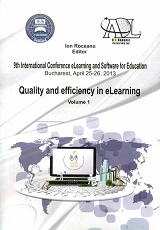THE DIFFERENT EFFECTS OF E-LEARNING TECHNOLOGY IN ROMANIAN HIGHER EDUCATION
THE DIFFERENT EFFECTS OF E-LEARNING TECHNOLOGY IN ROMANIAN HIGHER EDUCATION
Author(s): Radu Mircea Georgescu, Daniela PopescuSubject(s): Education
Published by: Carol I National Defence University Publishing House
Keywords: education; value of e-learning; lifelong learning
Summary/Abstract: The first steps in e-learning were designed for individual learning. In that stage there were few practical ways to integrate multiple learners or instructors into asynchronous self study e-learning. Actually, the traditional education system faces many changes arising from the development of the knowledge based economy. The past 10 years have seen dramatic changes in higher education in terms of increased access to education, lifelong learning, increased choice in areas of study and the personalization of learning. The widespread availability of digital learning resources in a variety of media formats, anytime and anywhere offers the possibility to make a profound difference in education. E-learning means not only Information and Communication Technologies, complex media or Internet. In the new vision e-learning is a complex field involving institutional, individual, technical and social components. This entire environment is changing dynamically day by day. The associated technologies are evolving rapidly especially the mobile communication technologies. E-learning is a success story from many years. Everybody talks about e-learning advantages and disadvantages but few about the necessity of standardization in this area. So, one of the major topics in the discussion about e-learning must be standards. With all the disappointing problems that e-learning systems had today, we must remain optimistic about the future. We must align the activities of training with the strategic objectives of the university. This paper describes and analyzes trends in the information technologies and the impact these have on the education sector as a whole, but particularly on the higher education sector.
Journal: Conference proceedings of »eLearning and Software for Education« (eLSE)
- Issue Year: 9/2013
- Issue No: 01
- Page Range: 492-498
- Page Count: 7
- Language: English

